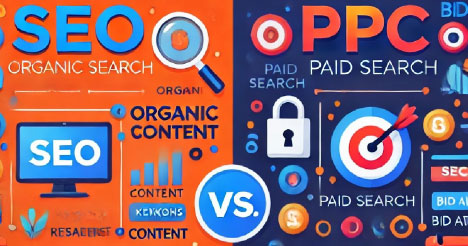SEO vs. PPC – What is Best for Your Business

Two strategies dominate the digital marketing world: Search Engine Optimization (SEO) and Pay-Per-Click (PPC) advertising. Both approaches can drive traffic and generate leads, but they operate in fundamentally different ways. Understanding the strengths and weaknesses of each can help you determine the best strategy for your business.
Let’s explore the key differences between SEO and PPC and provide insights into when and how to use them effectively.
What is SEO?
Search Engine Optimization (SEO) refers to the process of optimizing your website to improve its visibility on search engines like Google. The goal is to rank higher in organic (non-paid) search results for specific keywords related to your business. SEO involves a variety of tactics, including:
- Keyword Research: Identifying the search terms your target audience uses.
- On-Page Optimization: Enhancing content, meta tags and internal linking.
- Technical SEO: Improving website speed, mobile-friendliness and crawlability.
- Link Building: Acquiring high-quality backlinks from authoritative websites.
- Content Creation: Producing valuable and relevant content to attract and engage users.
What is PPC?
Pay-Per-Click (PPC) advertising is a model where businesses pay each time a user clicks on their ad. These ads appear at the top of search engine results pages (SERPs), above the organic results, and on various platforms such as Google Ads, social media and display networks. Key components of PPC include:
- Keyword Bidding: Selecting and bidding on keywords relevant to your ads.
- Ad Creation: Designing compelling ads that encourage clicks.
- Targeting: Defining your audience based on demographics, location, interests and behaviors.
- Budget Management: Setting daily or monthly budgets and managing bids to maximize ROI.
- Analytics and Reporting: Tracking performance and adjusting campaigns based on data.
SEO vs. PPC: Key Differences
Let’s cover the main differences between SEO and PPC.
Cost
SEO generally involves a lower ongoing cost but requires an upfront investment in time and resources. Once you achieve high rankings, the traffic is essentially free. PPC, on the other hand, requires continuous investment, as you pay for each click. Costs can add up quickly, especially for competitive keywords.
Time to Results
It takes time to see results from SEO, usually around 3-6 months or more to improve rankings and drive significant organic traffic. PPC delivers immediate results. As soon as your ads go live, they can start driving traffic to your site.
Longevity and Sustainability
SEO offers long-term benefits. High organic rankings can continue to drive traffic over time, even if you reduce your efforts. With PPC, you get short-term benefits. Traffic stops as soon as you pause your ad campaigns.
Click-Through Rates (CTR):
Generally, you’ll see higher CTRs with SEO. Users tend to trust organic results more than paid ads. But, PPC can achieve high CTRs too, especially for well-targeted and optimized ads. However, they can suffer from “ad blindness” where users ignore ads.
Control and Flexibility
SEO offers less control over rankings and traffic because algorithms change often. You have more control over placement with PPC ads, and you can quickly adjust your campaigns based on performance data.
When to Use SEO
- Long-Term Growth: If you aim for sustainable, long-term growth, investing in SEO is a wise choice.
- Content-Driven Strategy: SEO works well for businesses that can regularly produce valuable content.
- Building Authority: Great for establishing your site as an authority in your industry through high-quality content and backlinks.
- Budget Constraints: Ideal if you have limited funds for advertising but can invest time and effort.
When to Use PPC - Immediate Results: If you need quick traffic and immediate results, PPC is the way to go.
- Targeted Campaigns: Perfect for running highly targeted campaigns with specific goals, such as product launches or promotions.
- Testing and Data: Useful for testing different keywords, audiences and strategies to gather data and insights quickly.
- Competitive Markets: Effective in highly competitive markets where SEO might take too long to gain traction.
Combining SEO and PPC
In many cases, the best approach is to combine SEO and PPC strategies. These two strategies complement each other well. You can use PPC campaigns to test and identify high-performing keywords, then incorporate those into your SEO strategy. Furthermore, you can achieve maximum visibility by appearing in both organic and paid search results. Be sure to share performance data between SEO and PPC teams to optimize both strategies.
Conclusion
There is no one-size-fits-all answer to whether SEO or PPC is better. The best strategy depends on your business goals, budget and timeline. By understanding the strengths and weaknesses of each approach, you can make informed decisions and develop a marketing plan that leverages both SEO and PPC to drive traffic, generate leads and grow your business. To learn more about SEO and PPC and how they can work for you, contact KBDC, Inc., today.




